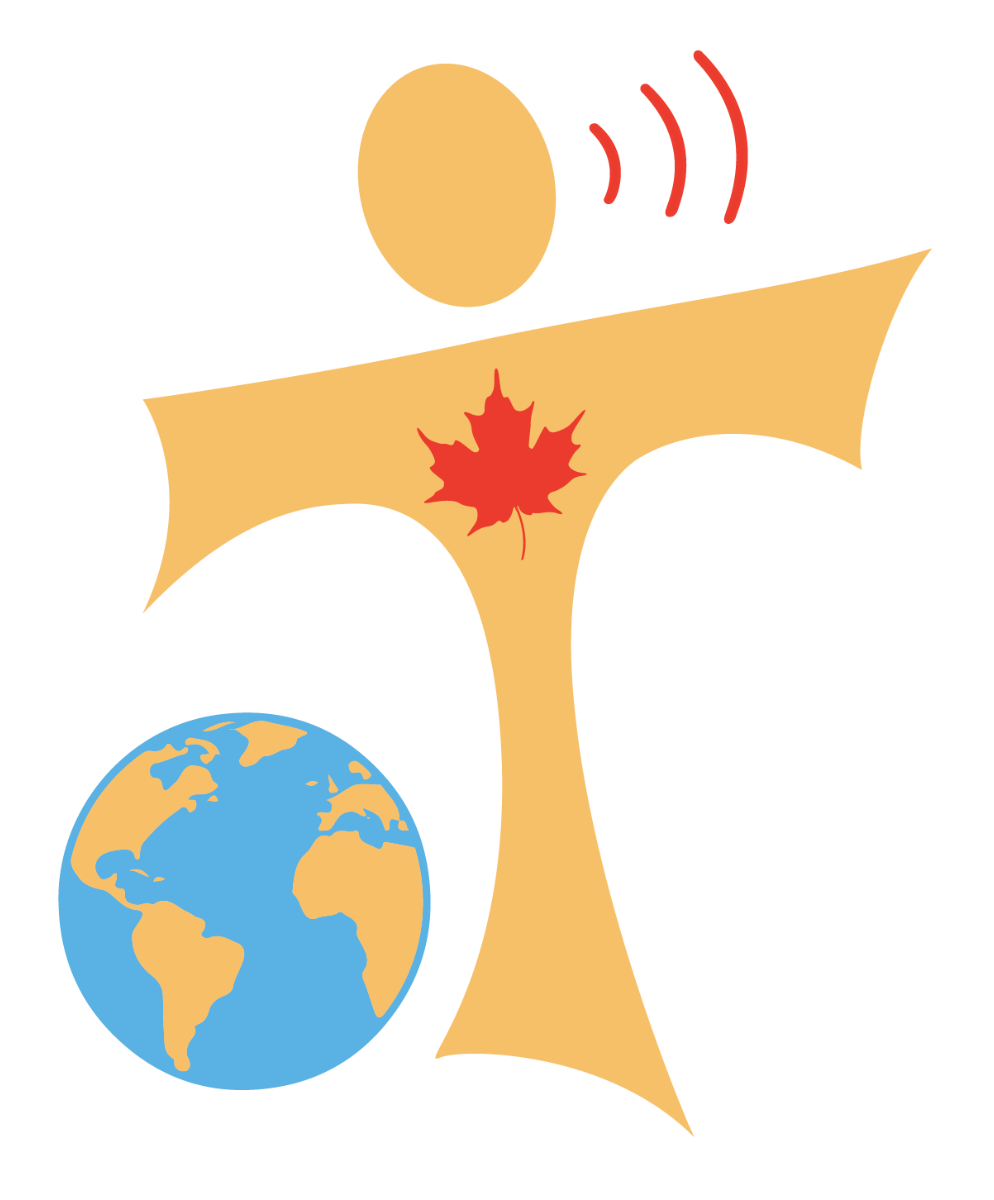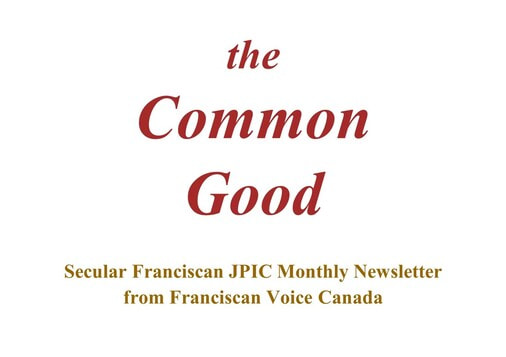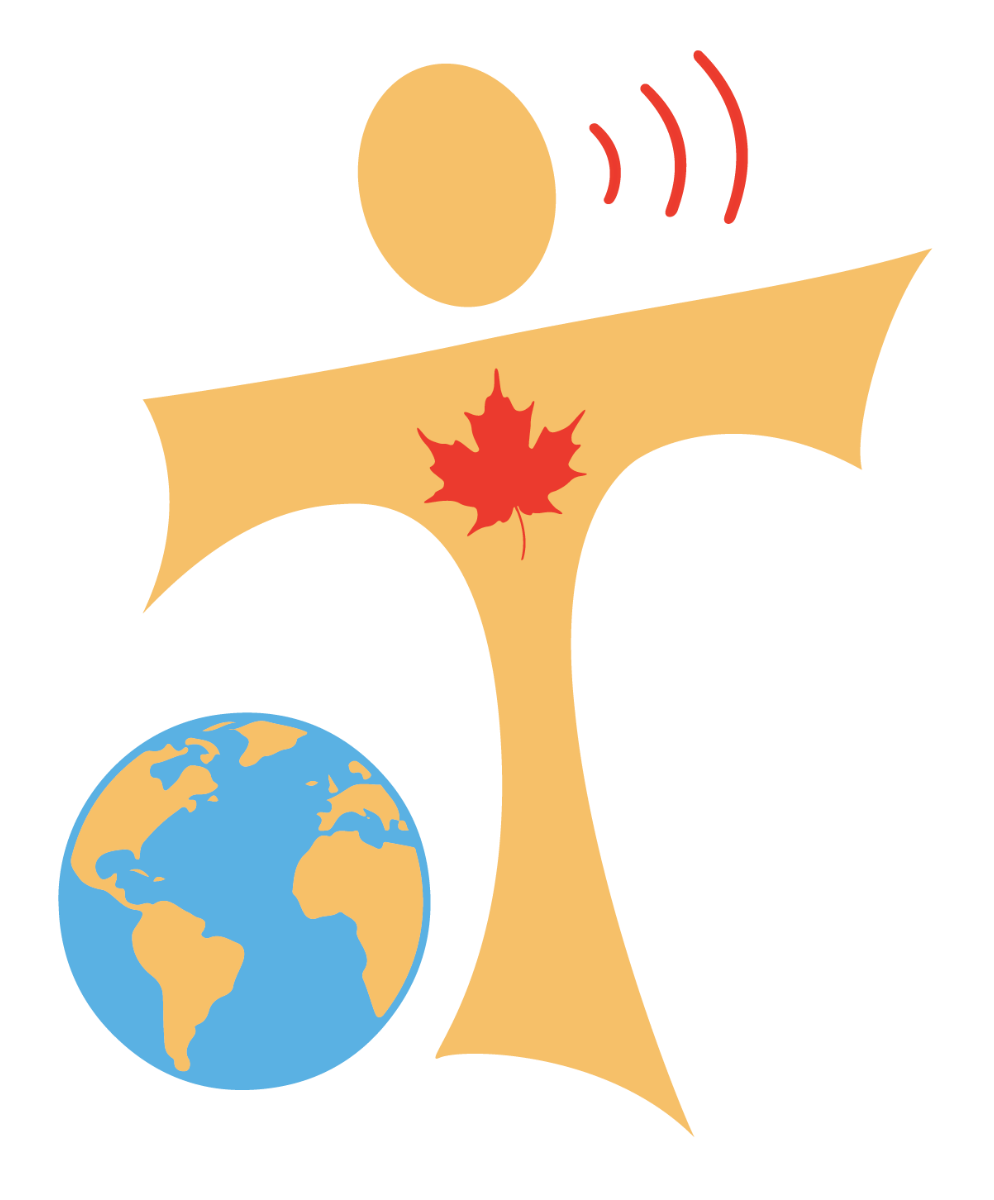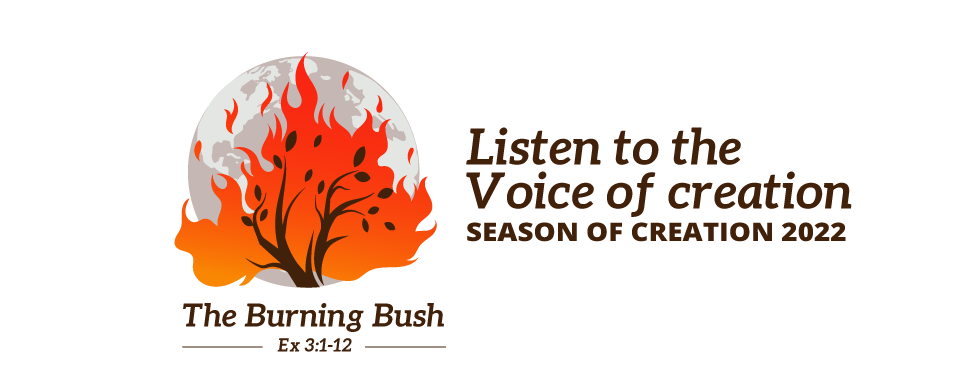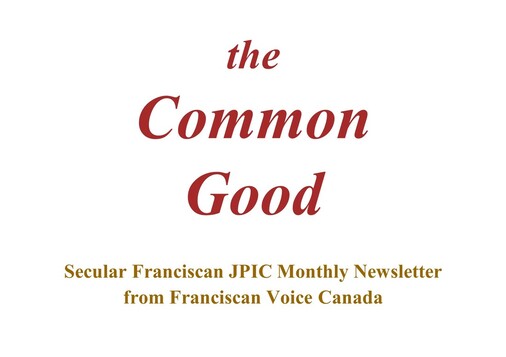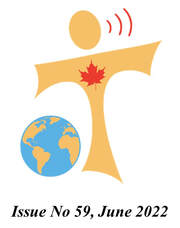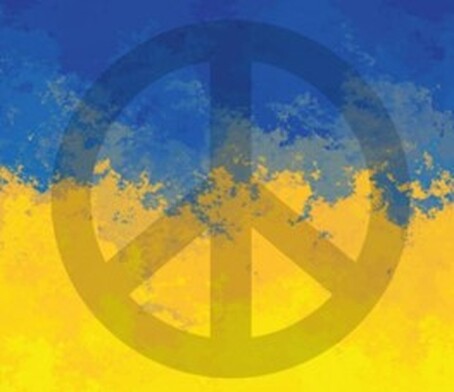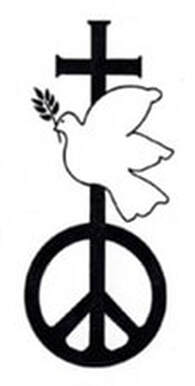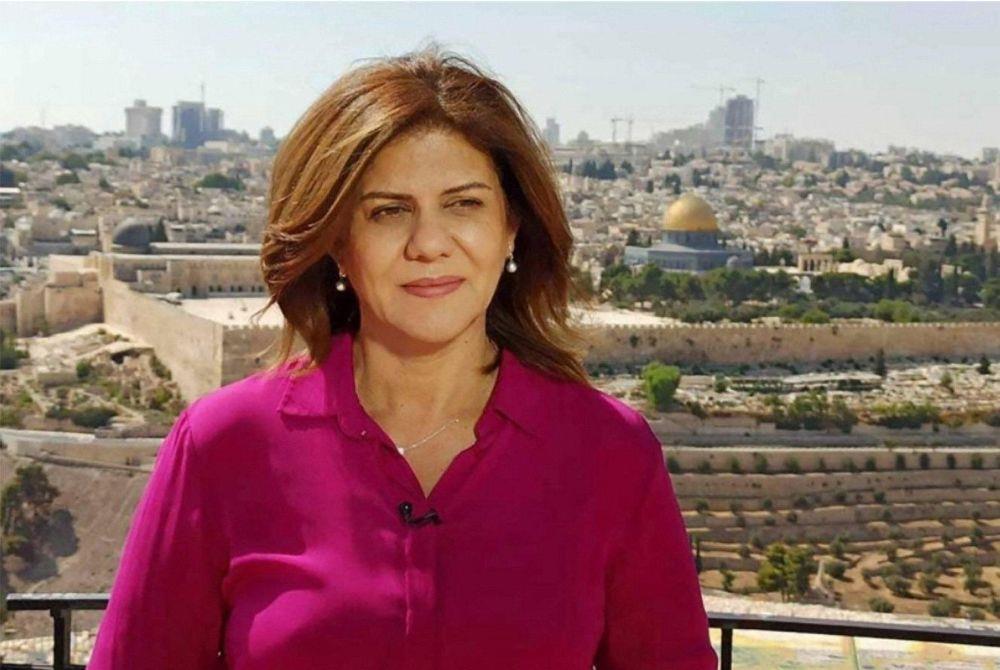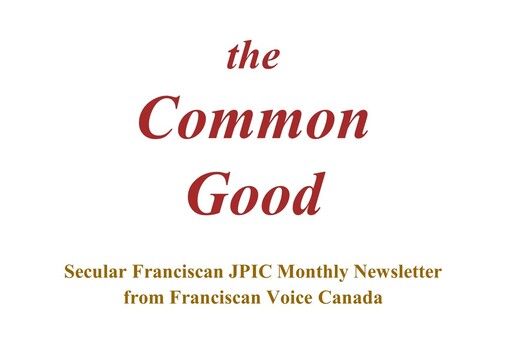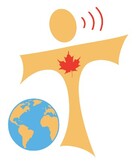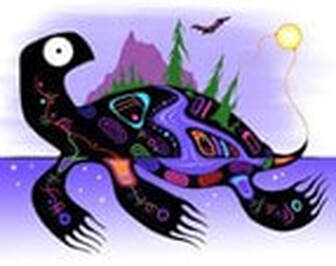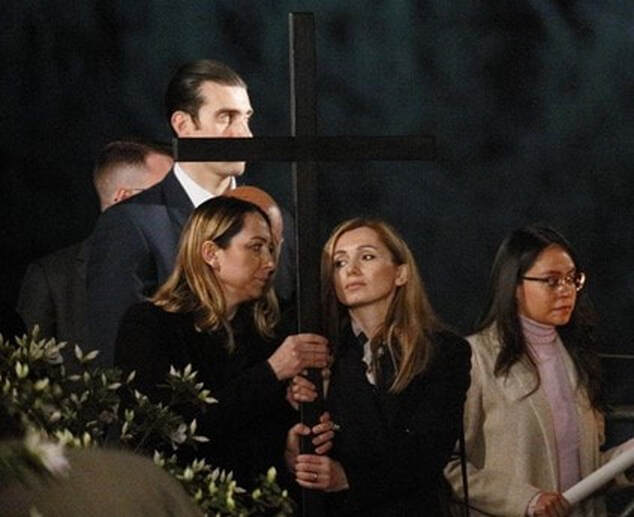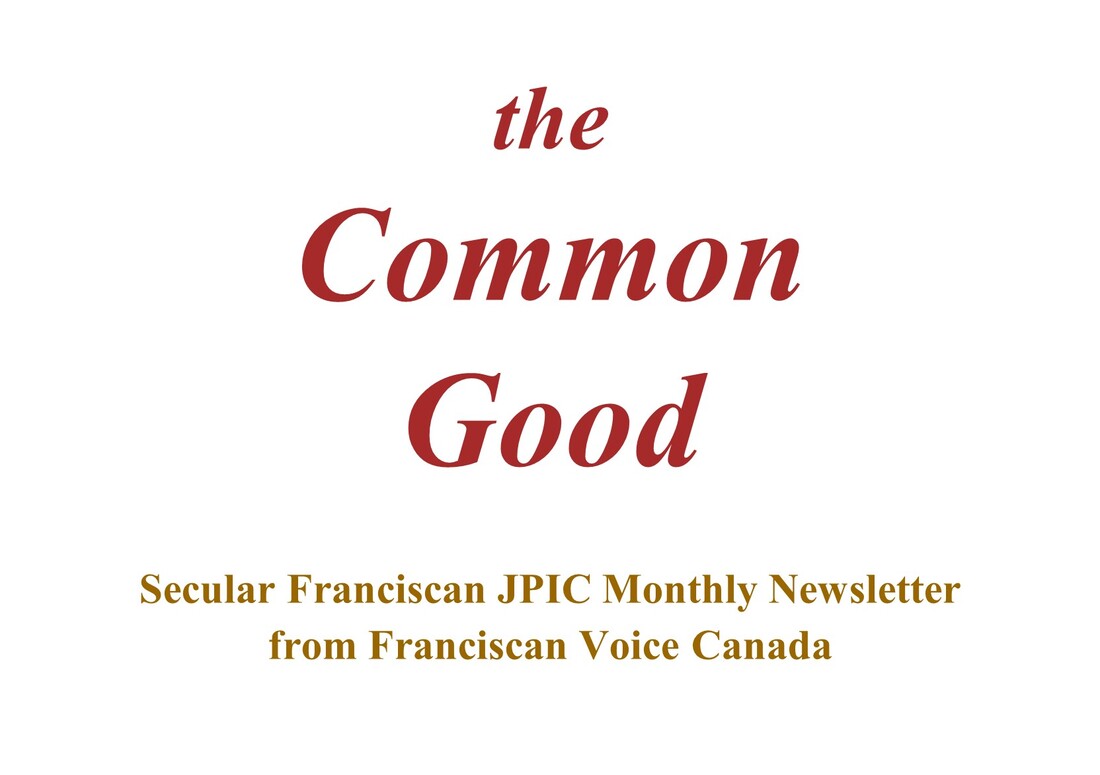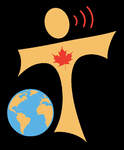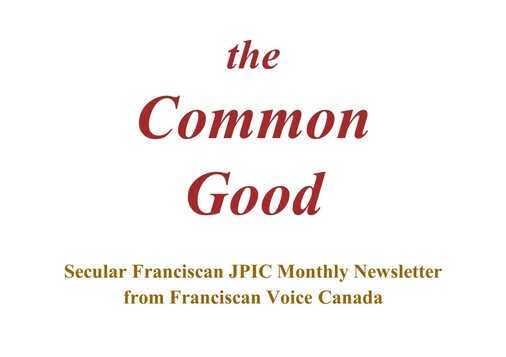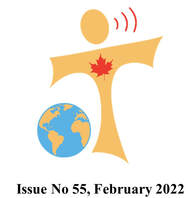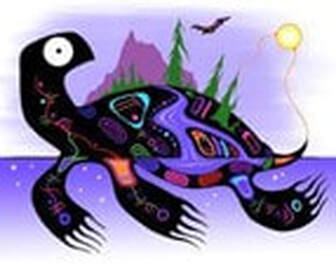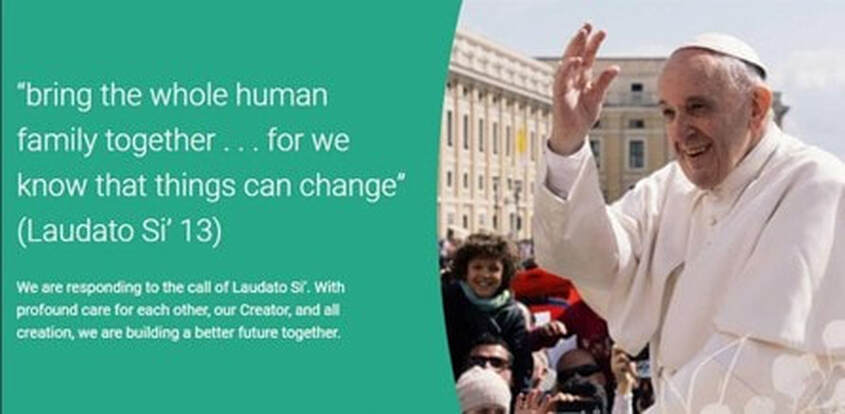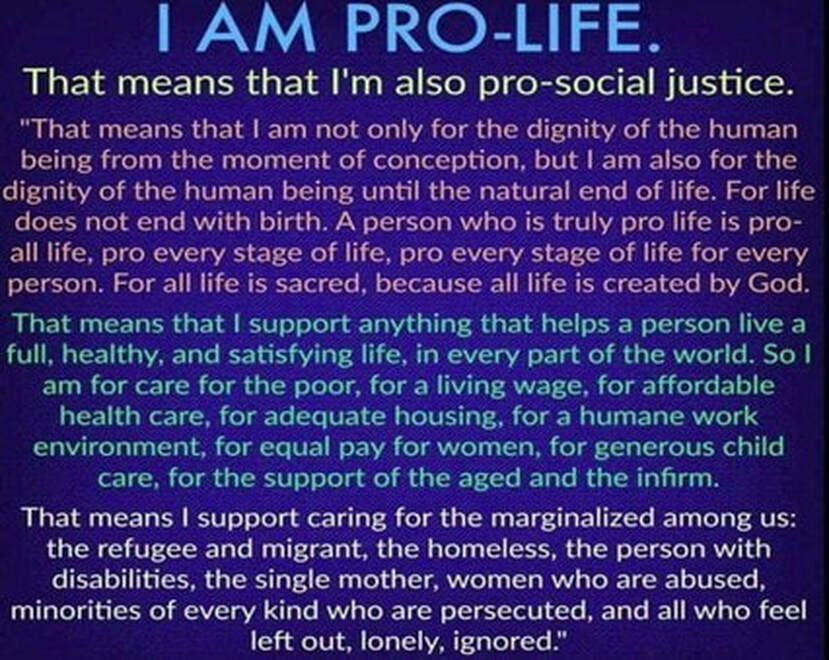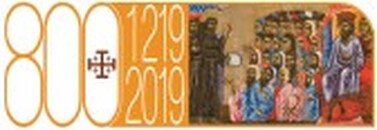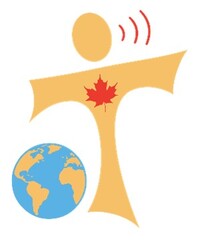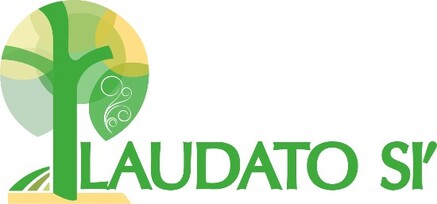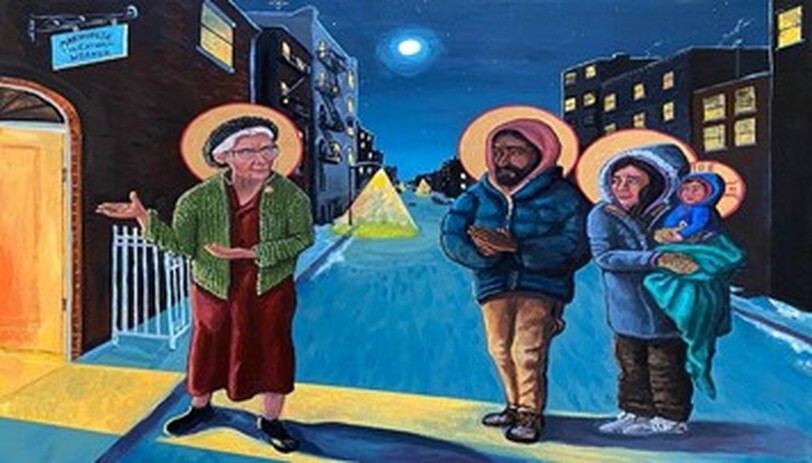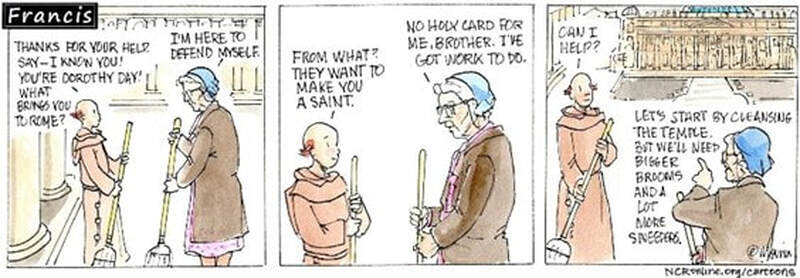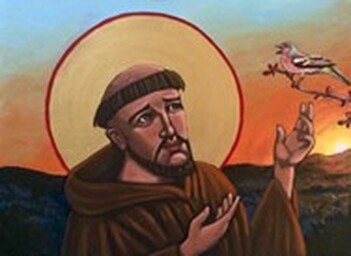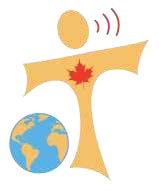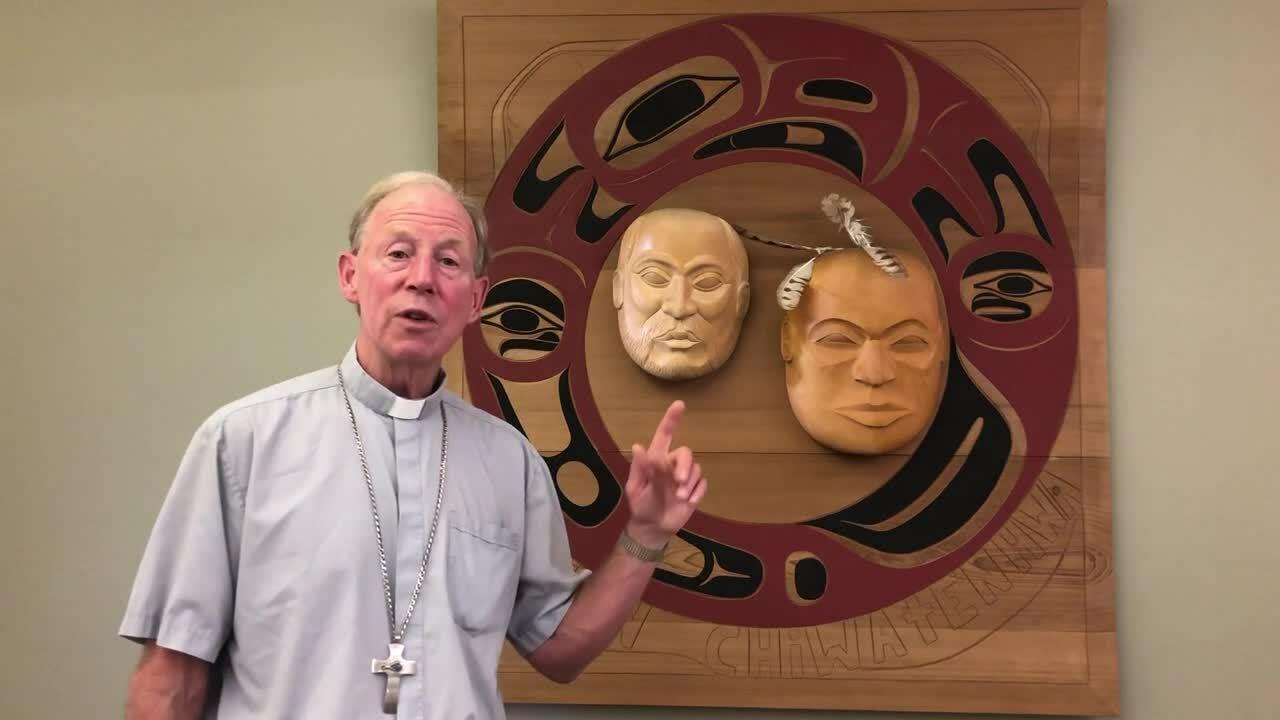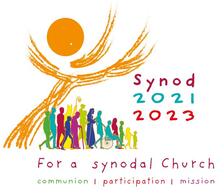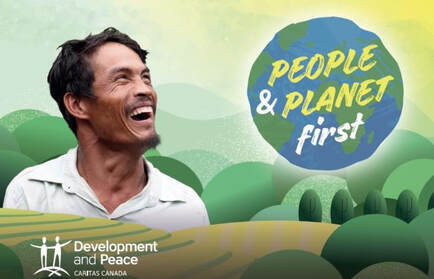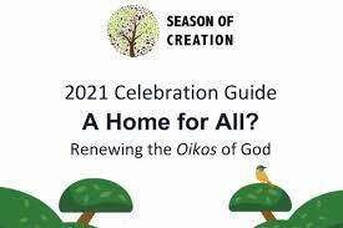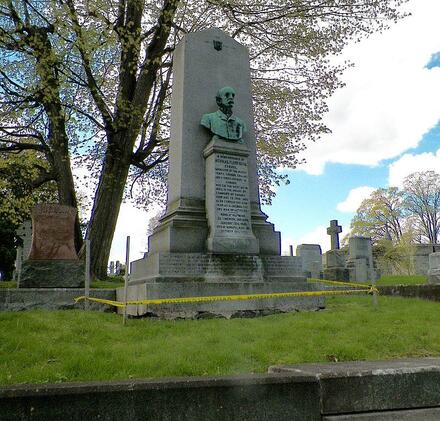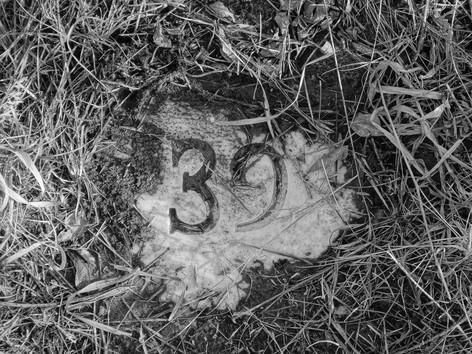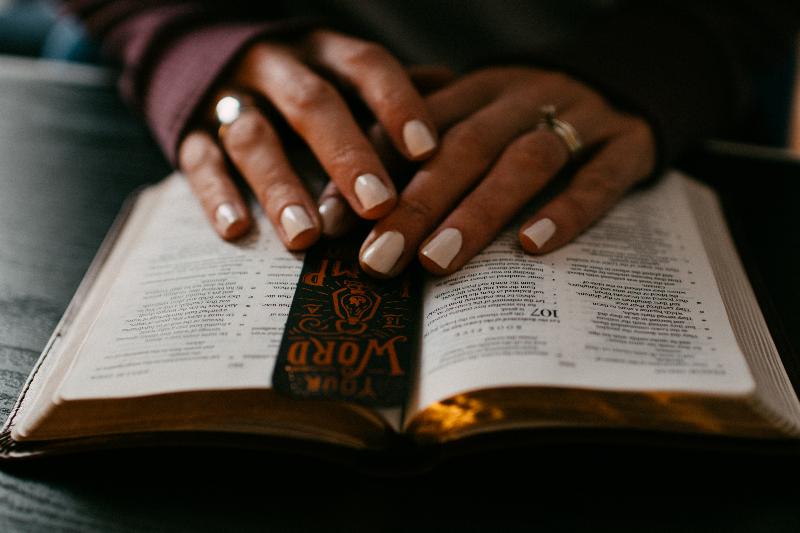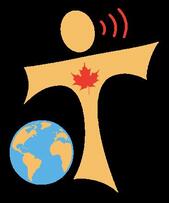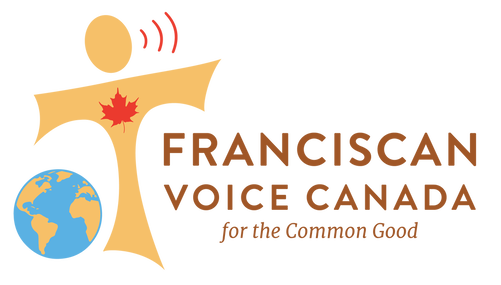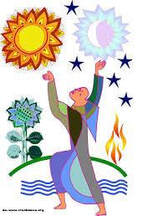The Common Good - December 2022 Newsletter
|
Secular Franciscan JPIC Monthly Newsletter
from Franciscan Voice Canada |
Issue No 64, December 2022
|
For Full Newsletter: Click Here
The Common Good - November 2022 Newsletter
Voir cette infolettre dans votre navigateur pour la traduire
Download Newsletter Here!
The Common Good - October 2022 Newsletter
The Common Good - September 2022 Newsletter
Franciscan Voice Canada acknowledges and thanks to the First Nations, Inuit and Métis peoples in Turtle Island for allowing us to live, pray, work, and play on their lands. We are deeply sorry for the injustices inflicted upon them by the complicity of settlers from racism in the colonialism inherent especially in the Indian Act and Residential Schools, including physical, sexual, emotional and all other forms of abuse resulting in cultural genocide. We commit to work for truth, healing and reconciliation.
Season of Creation 2022
Does your Diocese have a Laudato Si' Action Plan?
Does your diocese or parish have a LS Action Plan? Mine do not. Does OFS Canada and its Regions? I, a LS Animator, am hoping that I can help to bring one about. Learn more at Andrew's September blog #1
SPEAKING BOLDLY
Pope Francis encourages us in a Synodal church to speak boldly without fearing what others may think. The following is one way that needs to be taken seriously by the church:
Put our money where our mouth is!
Towards fossil free Churches
Towards fossil free Churches
We believe that churches need to divest from fossil fuel companies and invest in climate solutions if they are to retain their integrity in the face of the climate crisis.
According to the https://divestmentdatabase.org not one Canadian Catholic Diocese has divested. Have Canadian First Order Franciscans? Has OFS Canada? Read more #4
See what is being done in some other parts of the world: Check here.
According to the https://divestmentdatabase.org not one Canadian Catholic Diocese has divested. Have Canadian First Order Franciscans? Has OFS Canada? Read more #4
See what is being done in some other parts of the world: Check here.
WHAT YOU SHOULD KNOW AND CAN DO
Big banks like RBC are getting away with investing billions into the climate-killing fossil fuel industry, bankrolling massive projects like Coastal GasLink and TMX. So far, they’ve faced no consequences from banking regulators — but we have a rare opportunity to change that.
Right now the banks regulator — the Office of the Superintendent of Financial Institutions (OFSI) — is considering tightening up the rules on whether banks should be allowed to invest in the dirty oil and gas industry. And they want to hear from the public (that’s us!) about what they should do.
Right now the banks regulator — the Office of the Superintendent of Financial Institutions (OFSI) — is considering tightening up the rules on whether banks should be allowed to invest in the dirty oil and gas industry. And they want to hear from the public (that’s us!) about what they should do.
Take Action: Learn more at Andrew's September blog #5
Complete Newsletter - Download Here
The Common Good - June 2022 Newsletter
|
Franciscan Voice Canada acknowledges and thanks to the First Nations, Inuit and Métis peoples in Turtle Island for allowing us to live, pray, work, and play on their lands. We are deeply sorry for the injustices inflicted upon them by the complicity of settlers from racism in the colonialism inherent especially in the Indian Act and Residential Schools, including physical, sexual, emotional and all other forms of abuse resulting in cultural genocide.
|
DOUBLE SPEAK
TRUTH or FALSEHOOD
THE UKRAINIAN FLAG & PEACE SIGNS
A reader finds some of last month's content offensive. For those who may have thought the same Andrew offers some clarification. We continue to support what we have posted.
THE ROOT MEANING OF RELIGION AND RULE
Dan Horan OFM gives a definition of "religion" which leads us to think about our profession as OFS.
Read more at Andrew's Blog
"UKRAINIAN GRAIN MUST NOT BE USED
AS A WEAPON OF WAR"
"Of great concern," the Pope said, "is the blockade of grain exports from Ukraine, on which the lives of millions of people depend, especially in the poorest countries.
“I earnestly appeal for every effort to be made to resolve this issue and to guarantee the universal human right to food.”
Read more at Andrew's Blog #4 and the Vatican News
UKRAINIAN CATHOLIC PRELATE
TO BE RECOGNIZED AS PATRIARCH?
There are six Eastern Catholic patriarchates: (1) the Coptic Catholic Church, which is based in Egypt and is governed by the patriarch of Alexandria; (2, 3 & 4) three of Antioch, (one each for the Syrians, Maronites, and Greek Melkites); the Chaldean Catholic Church, which is based in Baghdad and is governed by the patriarch of Babylon of the Chaldeans (5); and the Armenian Catholic Church, which is based in Lebanon and is governed by the katholikos of Sis, or Cilicia (6).
But one Eastern Catholic Church, the Ukrainian Greek Catholic Church does not have a Patriarch. Instead it has a Major Archbishop. Why? So as not to offend the Russian Orthodox Church!
But one Eastern Catholic Church, the Ukrainian Greek Catholic Church does not have a Patriarch. Instead it has a Major Archbishop. Why? So as not to offend the Russian Orthodox Church!
Read more at Andrew's Blog #5
PRAYER FOR THE AFFLICTED PEOPLE
OF UKRAINE IN TIME OF WAR
“O Lord Jesus Christ, our God, we entreat You to hear the earnest prayer of Your beloved Church of Kyivan Rus’ for her deeply afflicted children abiding in the land of Ukraine. Behold their grave sorrow and grievous plight, and speedily come to their aid. Deliver Your vulnerable people from unjust aggressors, foreign invasion and the terror of war. Strengthen courageous defenders of the nation to fight virtuously, inspired more by love of those they protect than hatred of the enemy. O compassionate Lord, shelter the displaced, heal the wounded, console the orphan, protect the widow, comfort those who mourn, and mercifully receive into Your Kingdom those who have nobly died guarding their homeland against every aggression. Quickly make cease the spilling of blood of friend and foe alike, yet stir many to bravely struggle for that true justice which alone can bring lasting peace. O kind-hearted Lord, as You are our peace, soften the hearts of the unmerciful and convert those who promote hostilities toward reconciliation, so that Your beloved children of the land of Ukraine, may abide in that tranquility, justice and freedom which reflects your Kingdom, where You reign with Your eternal Father, and Your most holy, good and life-giving Spirit, now, and forever and ever. Amen.”
SHIREEN ABU AKLEH
REPORTER KILLED BY ISRAELI FORCES
Israeli forces shot Abu Akleh in the head while she was on assignment in Jenin in the occupied West Bank. Shireen Abu Akleh was a Palestinian American and a Greek-Melkite Catholic.
Read more at Andrew's Blog #6
Download Full Newsletter Here
The Common Good - May 2022 Newsletter
|
Franciscan Voice Canada acknowledges and thanks to the First Nations, Inuit and Métis peoples in Turtle Island for allowing us to live, pray, work, and play on their lands. We are deeply sorry for the injustices inflicted upon them by the complicity of settlers from racism in the colonialism inherent especially in the Indian Act and Residential Schools, including physical, sexual, emotional and all other forms of abuse resulting in cultural genocide. We commit to work for truth, healing and reconciliation.
|
UKRAINE – CLIMATE – FIRST NATIONS
LAUDATO SI’ WEEK 2022
Laudato Si’ 13: “Everything is connected”
As the Québec Bishops wrote in 2001: “On this point it is good to recall the conclusions already made in 1987, by the World Commission on Development and the Environment: Until recently, the planet was a large world in which human activities and their effects were neatly compartmentalized within nations, within sectors (energy, agriculture, trade), and within broad areas of concern (environmental, economic, social). These compartments have begun to dissolve. Read more...
1. Ukraine: ‘Putin’s altar boy’:
Pope Francis on Kirill
The Russian Orthodox Church scolded Pope Francis (4 May) for using the wrong tone after he urged Moscow Patriarch Kirill not to become Putin’s “altar boy,” cautioning the Vatican that such remarks would hurt dialog between the churches.
Read more at Andrew's Blog
Read more at Andrew's Blog
2. Ukraine: learning from the
Via Crucis 2022 (Coliseum)
According to the Vatican, 15 families were selected to write the Stations of the Cross meditations to mark the Amoris Laetitia Family Year, which will conclude on 26 June with the 10th edition of the World Meeting of Families, to be held in Rome... For the 13th station, “Jesus dies on the Cross,” a Ukrainian family and a Russian family were to read a reflection that they wrote together about how their lives were upended by the pain of war. Ukrainian nurse Iryna [or Irina] and Russian nursing student Albina met and became friends while studying nursing and working at a Rome medical university campus. They had told Vatican News on April 11 that such friendships were common, and many families are made up of the two nationalities, living in both or either country.
However, the original reflection was changed. Read more at Andrew's Blog
However, the original reflection was changed. Read more at Andrew's Blog
Download the full PDF file Here
The Common Good - April 2022 Newsletter
View this newsletter in your browser and translate
Voir cette infolettre dans votre navigateur pour la traduire
Voir cette infolettre dans votre navigateur pour la traduire
Ukraine Is Suffering - March 2022
View this newsletter in your browser and translate
Voir cette infolettre dans votre navigateur pour la traduire
Voir cette infolettre dans votre navigateur pour la traduire
View this newsletter in your browser and translate
Voir cette infolettre dans votre navigateur pour la traduire
Voir cette infolettre dans votre navigateur pour la traduire
|
The turtle: The Artist is Bernice Gordon (Walking with A'nó:wara, 2011) Turtle Island Conservation, Miskwaadesi and A’nó:wara. Curriculum Based Activities Guide, OISE, U of T. We believe they want the materials used by teachers and that includes us! Part of raising awareness and Truth & Reconciliation. Check it out yourself here. It is a wonderful resource for ongoing formation.
|
Franciscan Voice Canada acknowledges and thanks the First Nations, Inuit and Métis peoples in Turtle Island for allowing us to live, pray, work, and play on their lands. We are deeply sorry for the injustices inflicted upon them by the complicity of settlers from racism in the colonialism inherent especially in the Indian Act and Residential Schools, including physical, sexual, emotional and all other forms of abuse resulting in cultural genocide. We commit to work for truth, healing and reconciliation.
|
Pro-life is pro-social justice!
On the day after Christmas 2017, a national public television audience had the opportunity to experience the story of Sultan al-Malik al-Kāmil and Saint Francis of Assisi. An estimated audience of between three to six million viewers watched The Sultan and the Saint on their local PBS stations.
The film, written and directed by Alex Kronemer and narrated by Academy award-winner Jeremy Irons, has gone on to win “best documentary” at some 20 film festivals. It continues to be shown around the world, prompting local dialogue centering on this historic encounter.
Maryland-based Unity Productions produced the film. Founded in 1999 by two American Muslims. The Holy Land Review spoke with Unity’s Daniel Tutt, who served as associate producer and coordinates Unity’s educational outreach for its media. He explained that the founders “began a sort of reach-out campaign to the Muslim community here in the United States.” With a background in media, they were “interested in telling the story of this religion, of its history, of its culture, with the focus on broad education.”
Rather than focus only on a Muslim audience, Unity “would be reaching out, promoting interfaith engagement, promoting religious literacy and competency in understanding this religion.” He added, “You’re fighting almost a Sisyphean task [in the face] of the world’s political events. But it’s also an opportunity…[to look] at this culture and this religion in a different way. Our mission, therefore, is to counter a lot of the Islamophobia and the bigotry that exists in the Western European and American context.”
After Unity’s first film project, on the life of the Prophet Muhammad, the group recognized “that there’s more to be done with film than just broadcast, film festivals, awards, and screenings. There’s actually a relational component involved and an educational component…to get it in front of librarians, teachers, interfaith activists, pastors, rabbis and imams, to really drive conversations at a grassroots level around the films.
“We’ve been able to do a high quantity of engagements through support from different foundations, like the United States Institute of Peace, the Doris Duke Foundation for Islamic Art, the National Endowment for the Humanities, and many, many other family foundations, to really drive discussions, to reach wide numbers of people.”
A forgotten history
The Sultan and the Saint was Unity Production’s ninth documentary. Daniel Tutt pointed out that “in some ways, the story is still a forgotten history.” He added that “in interfaith circles, this story is certainly talked about, it’s certainly referenced, but those circles tend to be more academic. They tend to be folks that are in the know. I felt that the narrative was a very rich symbol for interfaith dialogue and encounter.
“On the one hand, you have [what] I would call ‘distorted histories’ on the Catholic side. And then on the Muslim side, you have a complete lack of awareness, mainly of the figure of alKamil, who, as you know, is eclipsed by the figure of Salah ad-Din [ruler of Egypt and Syria who fought and defeated the Crusader armies in the 12th century].
Franciscan author Sister Kathy Warren, who has written about the encounter from a Christian and Franciscan perspective (Daring to Cross the Threshold: Francis of Assisi Encounters Sultan Malek Al-Kamil) and appears in the film, resonated with the filmmakers’ approach: “For too many centuries the story was used to promote a message of Christian superiority. Unsubstantiated embellishments were added to the story to give a very different interpretation of Francis’ presence in the Muslim camp as well as his purpose in going there.”
Daniel Tutt said that Unity’s previous work focused on “bringing to life forgotten stories.” He added, “We had the idea of doing this film probably a decade prior. We had always kicked it around, sort of waiting for the right moment to do it. And I really think that what Pope Francis opened up, especially with his engagement with the Muslim world in a very positive way, felt that it was the right time to do this.”
Recreating a medieval story
The film is a “docudrama,” built around historical reenactments, supplemented by interviews with scholars. “We shot everything in Baltimore at a bottle-corking factory that had shut down and had been reconverted into a film studio in the harbor,” Tutt recalled. “All of the interior shots were recreated in that studio, and all the scholarly interviews….All of the exterior shots, the battle scenes, and all of the scenes of Francis and al-Kāmil in Egypt and Damietta were actually filmed at Assateague Island in Maryland.”
While the coast of Maryland substituted for the Mediterranean Ocean and the Nile River, the producers tried to make the other visual elements true to the story’s medieval setting. “All of the costuming was as authentic as we could get,” Tutt pointed out. “We not only interviewed the leading Franciscan historians and scholars on the encounter, but they also weighed in on costuming, scenes and background settings.” The goal? “To preserve as much authentic portrayal as possible.”
Research for the project stretched over two years before its November 2016 release. As part of that process, the producers interviewed some 25 experts over hundreds of hours to develop the working script. About a third of those scholars appear on camera. They provide expertise in Islam, Christianity and Judaism—including three Franciscan scholars.
Pulitzer-prize-winning journalist Paul Moses, whose popularly written book, The Saint and the Sultan, explored the lives of both al-Kāmil and Francis, appears in the film. “We consulted with Paul a great deal,” said Daniel Tutt, to present “a nice background story summary of the encounter. And I felt that his portraying it in such a way where secular audiences can resonate with it, is very important to keep the story still relevant.” Paul Moses agreed. “I was very happy to see the film being made,” he told The Holy Land Review. It’s done a lot to make the story better known. He added, “That’s what I was hoping for, to get the word out in a way a TV show could do.”
Violence and the human brain
One perspective unique to The Sultan and the Saint came from neuroscience. The producers wanted to explore how the religious and political conflict depicted in the film involved both the demonization of the other and its accompanying violence. The question, according to Tutt, was “What’s actually going on at this subjective level when people are thrown into violent situations?”
Dr. Emile Bruneau, a neuroscientist at the University of Pennsylvania’s Annenberg School for Communication, narrates how the human brain functions in violent conflict situations. His remarks are complemented by a mix of reenacted battle scenes with animation suggesting the working of the brain and nervous system. Bruneau has himself worked in conflict regions around the world and specializes in applying neuroscience to the study of hostility between political or religious groups.
The Crusades are the historical backdrop for the encounter in the film, which depicts the political and religious issues involved, as well as the reality that the Church’s efforts to re-claim the Holy Land for Christianity became sidetracked into violence against Jews and even Christians in the East, in addition to the de-humanization and bloody wars against the Muslims who were the declared enemies.
Daniel Tutt pointed out that the producers’ hope was to explore what took place. “Of course, it’s an incredibly complex phenomenon, like all social phenomenon are, but I think this [film] gives people a sort of framework to understand it.”
In doing so, the film does not shy away from a graphic depiction of the brutality of war. “If the film were rated it would be PG with violence,” Daniel Tutt observed. Franciscan historian Father Michael Cusato, who appears in the film, noted that “One of the most original—though not uncontroversial—aspects of the The Sultan and the Saint is its visual emphasis on the violence of the Fifth Crusade and of warfare in general.”
Other treatments of the Crusades have, Fr. Michael observed, “more often than not, soft-pedaled [it] in favor of putting the emphasis upon the religious fervor supposedly underpinning—and therefore, justifying—the extreme violence of the western Christian campaign to crush Muslim strongholds in the Holy Land. But the fact of the matter is that these were bloody, face-to-face, hand-to-hand clashes resulting in the deaths and injuries of thousands of men and women.”
Commenting on the film’s “exploration of the neurological processes which occur in human beings during moments of violent urges and actions,” he added, “by contrast the film asserts how those same processes can be reversed or abated when they are redirected towards more positive human relations and actions. This is really what the director of the film was trying to get at; and the pacific relationship struck up between Francis and al-Malik al-Kāmil is the prime example of how violent, ingrained urges can be transformed into something more positive and constructive.”
The film, written and directed by Alex Kronemer and narrated by Academy award-winner Jeremy Irons, has gone on to win “best documentary” at some 20 film festivals. It continues to be shown around the world, prompting local dialogue centering on this historic encounter.
Maryland-based Unity Productions produced the film. Founded in 1999 by two American Muslims. The Holy Land Review spoke with Unity’s Daniel Tutt, who served as associate producer and coordinates Unity’s educational outreach for its media. He explained that the founders “began a sort of reach-out campaign to the Muslim community here in the United States.” With a background in media, they were “interested in telling the story of this religion, of its history, of its culture, with the focus on broad education.”
Rather than focus only on a Muslim audience, Unity “would be reaching out, promoting interfaith engagement, promoting religious literacy and competency in understanding this religion.” He added, “You’re fighting almost a Sisyphean task [in the face] of the world’s political events. But it’s also an opportunity…[to look] at this culture and this religion in a different way. Our mission, therefore, is to counter a lot of the Islamophobia and the bigotry that exists in the Western European and American context.”
After Unity’s first film project, on the life of the Prophet Muhammad, the group recognized “that there’s more to be done with film than just broadcast, film festivals, awards, and screenings. There’s actually a relational component involved and an educational component…to get it in front of librarians, teachers, interfaith activists, pastors, rabbis and imams, to really drive conversations at a grassroots level around the films.
“We’ve been able to do a high quantity of engagements through support from different foundations, like the United States Institute of Peace, the Doris Duke Foundation for Islamic Art, the National Endowment for the Humanities, and many, many other family foundations, to really drive discussions, to reach wide numbers of people.”
A forgotten history
The Sultan and the Saint was Unity Production’s ninth documentary. Daniel Tutt pointed out that “in some ways, the story is still a forgotten history.” He added that “in interfaith circles, this story is certainly talked about, it’s certainly referenced, but those circles tend to be more academic. They tend to be folks that are in the know. I felt that the narrative was a very rich symbol for interfaith dialogue and encounter.
“On the one hand, you have [what] I would call ‘distorted histories’ on the Catholic side. And then on the Muslim side, you have a complete lack of awareness, mainly of the figure of alKamil, who, as you know, is eclipsed by the figure of Salah ad-Din [ruler of Egypt and Syria who fought and defeated the Crusader armies in the 12th century].
Franciscan author Sister Kathy Warren, who has written about the encounter from a Christian and Franciscan perspective (Daring to Cross the Threshold: Francis of Assisi Encounters Sultan Malek Al-Kamil) and appears in the film, resonated with the filmmakers’ approach: “For too many centuries the story was used to promote a message of Christian superiority. Unsubstantiated embellishments were added to the story to give a very different interpretation of Francis’ presence in the Muslim camp as well as his purpose in going there.”
Daniel Tutt said that Unity’s previous work focused on “bringing to life forgotten stories.” He added, “We had the idea of doing this film probably a decade prior. We had always kicked it around, sort of waiting for the right moment to do it. And I really think that what Pope Francis opened up, especially with his engagement with the Muslim world in a very positive way, felt that it was the right time to do this.”
Recreating a medieval story
The film is a “docudrama,” built around historical reenactments, supplemented by interviews with scholars. “We shot everything in Baltimore at a bottle-corking factory that had shut down and had been reconverted into a film studio in the harbor,” Tutt recalled. “All of the interior shots were recreated in that studio, and all the scholarly interviews….All of the exterior shots, the battle scenes, and all of the scenes of Francis and al-Kāmil in Egypt and Damietta were actually filmed at Assateague Island in Maryland.”
While the coast of Maryland substituted for the Mediterranean Ocean and the Nile River, the producers tried to make the other visual elements true to the story’s medieval setting. “All of the costuming was as authentic as we could get,” Tutt pointed out. “We not only interviewed the leading Franciscan historians and scholars on the encounter, but they also weighed in on costuming, scenes and background settings.” The goal? “To preserve as much authentic portrayal as possible.”
Research for the project stretched over two years before its November 2016 release. As part of that process, the producers interviewed some 25 experts over hundreds of hours to develop the working script. About a third of those scholars appear on camera. They provide expertise in Islam, Christianity and Judaism—including three Franciscan scholars.
Pulitzer-prize-winning journalist Paul Moses, whose popularly written book, The Saint and the Sultan, explored the lives of both al-Kāmil and Francis, appears in the film. “We consulted with Paul a great deal,” said Daniel Tutt, to present “a nice background story summary of the encounter. And I felt that his portraying it in such a way where secular audiences can resonate with it, is very important to keep the story still relevant.” Paul Moses agreed. “I was very happy to see the film being made,” he told The Holy Land Review. It’s done a lot to make the story better known. He added, “That’s what I was hoping for, to get the word out in a way a TV show could do.”
Violence and the human brain
One perspective unique to The Sultan and the Saint came from neuroscience. The producers wanted to explore how the religious and political conflict depicted in the film involved both the demonization of the other and its accompanying violence. The question, according to Tutt, was “What’s actually going on at this subjective level when people are thrown into violent situations?”
Dr. Emile Bruneau, a neuroscientist at the University of Pennsylvania’s Annenberg School for Communication, narrates how the human brain functions in violent conflict situations. His remarks are complemented by a mix of reenacted battle scenes with animation suggesting the working of the brain and nervous system. Bruneau has himself worked in conflict regions around the world and specializes in applying neuroscience to the study of hostility between political or religious groups.
The Crusades are the historical backdrop for the encounter in the film, which depicts the political and religious issues involved, as well as the reality that the Church’s efforts to re-claim the Holy Land for Christianity became sidetracked into violence against Jews and even Christians in the East, in addition to the de-humanization and bloody wars against the Muslims who were the declared enemies.
Daniel Tutt pointed out that the producers’ hope was to explore what took place. “Of course, it’s an incredibly complex phenomenon, like all social phenomenon are, but I think this [film] gives people a sort of framework to understand it.”
In doing so, the film does not shy away from a graphic depiction of the brutality of war. “If the film were rated it would be PG with violence,” Daniel Tutt observed. Franciscan historian Father Michael Cusato, who appears in the film, noted that “One of the most original—though not uncontroversial—aspects of the The Sultan and the Saint is its visual emphasis on the violence of the Fifth Crusade and of warfare in general.”
Other treatments of the Crusades have, Fr. Michael observed, “more often than not, soft-pedaled [it] in favor of putting the emphasis upon the religious fervor supposedly underpinning—and therefore, justifying—the extreme violence of the western Christian campaign to crush Muslim strongholds in the Holy Land. But the fact of the matter is that these were bloody, face-to-face, hand-to-hand clashes resulting in the deaths and injuries of thousands of men and women.”
Commenting on the film’s “exploration of the neurological processes which occur in human beings during moments of violent urges and actions,” he added, “by contrast the film asserts how those same processes can be reversed or abated when they are redirected towards more positive human relations and actions. This is really what the director of the film was trying to get at; and the pacific relationship struck up between Francis and al-Malik al-Kāmil is the prime example of how violent, ingrained urges can be transformed into something more positive and constructive.”
Who was the sultan?
Daniel Tutt pointed out that “St. Francis has thousands of pages written about him. al-Kāmil on the other hand, is a fascinating figure but in many ways unknown in [our] contemporary period both to Muslims and to the West.
“But this was not the case during his own time. Here’s a man who was a fond admirer of scholars. He was an incredible diplomat. He was an incredible military tactician and strategist, and what we discovered through research was [that he was] very much a catalyst to rerouting the Crusades from having to do with the attainment of Jerusalem.
“When he created the peace after the Fifth Crusade over Jerusalem, this was a significant event in the history of the Crusades. Of course, it did not end the Crusades, but it was a moment that shaped the future direction and de-intensified the conflict towards a more peaceful resolution.”
As in every docudrama, Tutt noted, artistic and scholarly choices had to be made, especially about figures like Francis and al-Kāmil, whose stories have been embellished and even distorted over time. “We would always choose to emphasize a fact or a story line that had general scholarly consensus. We didn’t adopt any of the outlandish ideas, like al-Kāmil was a secret Christian. We tried to stick very much to the main stream of the scholarship.”
Daniel Tutt pointed out that “St. Francis has thousands of pages written about him. al-Kāmil on the other hand, is a fascinating figure but in many ways unknown in [our] contemporary period both to Muslims and to the West.
“But this was not the case during his own time. Here’s a man who was a fond admirer of scholars. He was an incredible diplomat. He was an incredible military tactician and strategist, and what we discovered through research was [that he was] very much a catalyst to rerouting the Crusades from having to do with the attainment of Jerusalem.
“When he created the peace after the Fifth Crusade over Jerusalem, this was a significant event in the history of the Crusades. Of course, it did not end the Crusades, but it was a moment that shaped the future direction and de-intensified the conflict towards a more peaceful resolution.”
As in every docudrama, Tutt noted, artistic and scholarly choices had to be made, especially about figures like Francis and al-Kāmil, whose stories have been embellished and even distorted over time. “We would always choose to emphasize a fact or a story line that had general scholarly consensus. We didn’t adopt any of the outlandish ideas, like al-Kāmil was a secret Christian. We tried to stick very much to the main stream of the scholarship.”
Who was the saint?
“We did not decide to paint St. Francis as a kind of new ager, as a kind of figure who was above religion,” Tutt explained. “Rather, we tried to show that, in fact, he was a medieval Christian who most likely went to the Sultan with the interest in converting him. And that is a beautiful thing from a storytelling standpoint, because here you see a wonderful transformation, and we tried to show that transformation in the film.” The filmmakers highlighted “the modification that Francis made to the rules of his order on how to deal with religious ‘others,’ particularly Muslims. [This] is sort of the proof that his encounter with the Sultan was not only something that was subjectively transformative but actually was institutionally transformative for the Franciscan Order.”
Sr. Kathy Warren underscored the deeper lessons of the film. “I agree with the film’s perspective that Francis was not a supporter of the crusades, especially to settle such major conflicts. I believe the portrayal of the dialogue and the respect shown between Francis and al-Kamil offers a powerful method for dealing with conflict today.”
Sr. Kathy explained that “Francis was a master at understanding and embracing the human condition—the whole of it—the joys and the struggles. I believe this is one of the traits that makes Francis one of the most well-known persons in history. Francis’ approach to Islam was simply a stretching of the understanding he had come to about the human condition. Francis, through his encounter with a leper, came to understand that every human being, without exception, is brother and sister. This insight is rooted in the belief that each of us have the same Creator, the One God, from who we come and to whom we are all returning.”
She noted that “this key insight meant that all those who were ‘officially’ excluded from the society in which Francis lived prior to his ‘conversion’—lepers, heretics, Jews, Muslims, etc.—were not ‘others.’ Francis came to realize the universal kinship of all of humanity, no exceptions. Thus, he approached the Muslims in the Sultan’s camp not as ‘the hated enemy’ or ‘the beast,’ but as his own brothers and sisters.” The story, she said, “helps us to realize how very radical Francis’ approach to living in the world and in the Church was and continues to be.
A continuing impact
Daniel Tutt and the team at Unity Productions are pleased with the film’s impact, particularly in its educational outreach. “I think the impact, in addition to the broadcast, the film festivals, and the international distribution of the film, has been most felt at the educational grassroots engagement level,” he said. “To date, we’ve had 5,000 requests from institutions for the film. So this means they’re either receiving it, in most cases, on DVD and will be hopefully screening it multiple times either in the classroom, at the library, at the congregation, etc. That reaches deep.”
Unity has a campaign in the United States to foster dialogue between Christian evangelicals and Pentecostals, with Muslim communities. To date, Tutt says, “We’ve had 50 encounter events with the film….where evangelicals use the film as an invitation to bring Muslims into their sacred space and have a dialogue. It’s very exciting.”
For this anniversary year, Daniel Tutt said he hopes “this docudrama, addressing such an important event in history, when you do it in such a way that resonates for the long duration,…becomes evergreen and can be utilized as a tool for many years. It doesn’t go out of fashion.”
Sr. Kathy Warren, from a Franciscan perspective, has found a positive reaction: “I have shown the film to several audiences and found that it shocks, offends, stretches, enlightens and even angers.” She recalled the reaction of one viewer, who observed during a discussion following a viewing of The Sultan and the Saint, “I think this film and this discussion is turning me into a ‘recovering Islamophobe.’ I am so grateful that I came tonight, and I have much to think about. I know I will attend the follow up session at the mosque to continue hearing about the parts of this reality that I’ve never had the opportunity to encounter.”
“We did not decide to paint St. Francis as a kind of new ager, as a kind of figure who was above religion,” Tutt explained. “Rather, we tried to show that, in fact, he was a medieval Christian who most likely went to the Sultan with the interest in converting him. And that is a beautiful thing from a storytelling standpoint, because here you see a wonderful transformation, and we tried to show that transformation in the film.” The filmmakers highlighted “the modification that Francis made to the rules of his order on how to deal with religious ‘others,’ particularly Muslims. [This] is sort of the proof that his encounter with the Sultan was not only something that was subjectively transformative but actually was institutionally transformative for the Franciscan Order.”
Sr. Kathy Warren underscored the deeper lessons of the film. “I agree with the film’s perspective that Francis was not a supporter of the crusades, especially to settle such major conflicts. I believe the portrayal of the dialogue and the respect shown between Francis and al-Kamil offers a powerful method for dealing with conflict today.”
Sr. Kathy explained that “Francis was a master at understanding and embracing the human condition—the whole of it—the joys and the struggles. I believe this is one of the traits that makes Francis one of the most well-known persons in history. Francis’ approach to Islam was simply a stretching of the understanding he had come to about the human condition. Francis, through his encounter with a leper, came to understand that every human being, without exception, is brother and sister. This insight is rooted in the belief that each of us have the same Creator, the One God, from who we come and to whom we are all returning.”
She noted that “this key insight meant that all those who were ‘officially’ excluded from the society in which Francis lived prior to his ‘conversion’—lepers, heretics, Jews, Muslims, etc.—were not ‘others.’ Francis came to realize the universal kinship of all of humanity, no exceptions. Thus, he approached the Muslims in the Sultan’s camp not as ‘the hated enemy’ or ‘the beast,’ but as his own brothers and sisters.” The story, she said, “helps us to realize how very radical Francis’ approach to living in the world and in the Church was and continues to be.
A continuing impact
Daniel Tutt and the team at Unity Productions are pleased with the film’s impact, particularly in its educational outreach. “I think the impact, in addition to the broadcast, the film festivals, and the international distribution of the film, has been most felt at the educational grassroots engagement level,” he said. “To date, we’ve had 5,000 requests from institutions for the film. So this means they’re either receiving it, in most cases, on DVD and will be hopefully screening it multiple times either in the classroom, at the library, at the congregation, etc. That reaches deep.”
Unity has a campaign in the United States to foster dialogue between Christian evangelicals and Pentecostals, with Muslim communities. To date, Tutt says, “We’ve had 50 encounter events with the film….where evangelicals use the film as an invitation to bring Muslims into their sacred space and have a dialogue. It’s very exciting.”
For this anniversary year, Daniel Tutt said he hopes “this docudrama, addressing such an important event in history, when you do it in such a way that resonates for the long duration,…becomes evergreen and can be utilized as a tool for many years. It doesn’t go out of fashion.”
Sr. Kathy Warren, from a Franciscan perspective, has found a positive reaction: “I have shown the film to several audiences and found that it shocks, offends, stretches, enlightens and even angers.” She recalled the reaction of one viewer, who observed during a discussion following a viewing of The Sultan and the Saint, “I think this film and this discussion is turning me into a ‘recovering Islamophobe.’ I am so grateful that I came tonight, and I have much to think about. I know I will attend the follow up session at the mosque to continue hearing about the parts of this reality that I’ve never had the opportunity to encounter.”
For more information on The Sultan and the Saint:
www.sultanandthesaintfilm.com See Complete Newsletter Here
www.sultanandthesaintfilm.com See Complete Newsletter Here
Making Ecocide A Crime
View this newsletter in your browser and translate
Voir cette infolettre dans votre navigateur pour la traduire
Voir cette infolettre dans votre navigateur pour la traduire
Calling on World Leaders!
Jojo Mehta, co-founder of Stop Ecocide talks about
taking forward the work of Earth Lawyer Polly Higgins.
taking forward the work of Earth Lawyer Polly Higgins.
Ecocide defined: “unlawful or wanton acts committed with knowledge that there is a substantial likelihood of severe and either widespread or longterm damage to the environment.”
A Plea to Make Widespread Environmental Damage an International Crime
Takes Centre Stage at The Hague
The idea to add ecocide as the court’s fifth crime gained traction in 2019. Since then, Pope Francis, U.N. Secretary General António Guterres and more than a dozen countries, including Mexico, France, Sweden and Canada, have expressed varying degrees of support for the international initiative. Earlier [December 2021], Belgium’s parliament passed a resolution expressing support for both domestic ecocide legislation and the international effort. Learn more at Andrew's Blog #4
A Plea to Make Widespread Environmental Damage an International Crime
Takes Centre Stage at The Hague
The idea to add ecocide as the court’s fifth crime gained traction in 2019. Since then, Pope Francis, U.N. Secretary General António Guterres and more than a dozen countries, including Mexico, France, Sweden and Canada, have expressed varying degrees of support for the international initiative. Earlier [December 2021], Belgium’s parliament passed a resolution expressing support for both domestic ecocide legislation and the international effort. Learn more at Andrew's Blog #4
“Society, through non-governmental organizations and intermediate groups, must put pressure on governments to develop more rigorous regulations, procedures and controls. Unless citizens control political power – national, regional and municipal – it will not be possible to control damage to the environment. Local legislation can be more effective, too, if agreements exist between neighbouring communities to support the same environmental policies.” LS 179
The Mystery of the Christian Faith
One thing I [Andrew] rediscovered from Advent was from Henri Nouwen’s Advent Devotions, Monday of the Third Week of Advent: “We can probe the heights and the depths of the material universe and contemplate the deepest complexities of metaphysics and still not come close to understanding God in his divinity.” But that does not stop us trying!
I remember a cherished pastor telling me: “Never let go of the mystery of our faith.” At this moment I summarize it thus: We believe in the Holy Trinity, the Immaculate Conception and the Holy Family and that we are made in the image of God. We are like Him yet so unlike Him but strive to imitate Him.
I remember a cherished pastor telling me: “Never let go of the mystery of our faith.” At this moment I summarize it thus: We believe in the Holy Trinity, the Immaculate Conception and the Holy Family and that we are made in the image of God. We are like Him yet so unlike Him but strive to imitate Him.
Calling for a new way of thinking, feeling, understanding and living
The Laudato Si’ Action Platform empowers the universal Church and all people of good will to respond to Laudato Si’, Pope Francis’ encyclical on caring for our common home.
The Laudato Si’ Action Platform empowers the universal Church and all people of good will to respond to Laudato Si’, Pope Francis’ encyclical on caring for our common home.
BUILDING A BETTER FUTURE–TOGETHER
You are warmly invited to review the Planning Guide to find more information on reflecting on your values, strengthening your decision-making process, and creating your Laudato Si’ Plan. As a first step in your journey to integral ecology, you are invited to complete your first annual self-assessment.
Go to https://laudatosiactionplatform.org/dashboard/ to take this step.
You will have to register
You will have to register
Roundup - Glyphosate
|
In June 2021, the EU voted for a renewal of Glyphosate. We were able to stop the Commission's plans for a renewal of 15 years. The licence got renewed for only 18 months. It is currently approved for use in the EU until 15 December 2022.
Petition: Sign to stop glyphosate in Europe Then tell our governments to do the same |
Pope’s Christmas Homily
In his Christmas mass homily the Holy Father reminds us that Jesus shows the way from littleness to greatness. An angel tells the shepherds how to find the God who has come down to earth: “This will be a sign for you: you will find a child wrapped in swaddling cloths, and lying in a manger” (v. 12). That is the sign: a child, a baby lying in the dire poverty of a manger. … His is a message of immense hope. Jesus asks us to rediscover and value the little things in life. If he is present there, what else do we need? Let us stop pining for a grandeur that is not ours to have. Let us put aside our complaints and our gloomy faces, and the greed that never satisfies! Littleness and the amazement of that little child: this is the message. Read his full message at Andrew's Blog #9.a.
Pope 55th World Day of Peace 1 January 2022
Dialogue Between Generations, Education and Work: Tools for Building Lasting Peace
“Today the path of peace, which Saint Paul VI called by the new name of integral development, [1] remains sadly distant from the real lives of many men and women and thus from our human family, which is now entirely interconnected. … Read More
“Today the path of peace, which Saint Paul VI called by the new name of integral development, [1] remains sadly distant from the real lives of many men and women and thus from our human family, which is now entirely interconnected. … Read More
Download Complete PDF Newsletter Here
View this newsletter in your browser and translate
Voir cette infolettre dans votre navigateur pour la traduire
Voir cette infolettre dans votre navigateur pour la traduire
"I Have This Hope"
Let us begin with this song can be seen as a prayer
Tenth Avenue North "I Have This Hope"
Here's a comment: This song and his voice touches deep
inside. The emotions come out and tears are non stop,
because my spirit speaks to the God Almighty. Jesus has held
me throughout every storm. What is your storm, how is Jesus
holding you, are you holding on to him?
A great song of hope.
Here's a comment: This song and his voice touches deep
inside. The emotions come out and tears are non stop,
because my spirit speaks to the God Almighty. Jesus has held
me throughout every storm. What is your storm, how is Jesus
holding you, are you holding on to him?
A great song of hope.
Journey through Advent 2021:
Towards Healing & Reconciliation
Towards Healing & Reconciliation
The Journey series started on the Solemnity of Christ the King and will continue through each of the four Sundays of Advent. Every week, the Canadian Conference of Catholic Bishops [CCCB] will be releasing a reflection by Archbishop Don Bolen, on the Gospel Reading for that Sunday. Each reflection is based on one of the five essential stages of reconciliation: examen, confession, repentance, making amends, and reconciliation.
Learn More at Andrew's Blog
Also read about:
Learn More at Andrew's Blog
Also read about:
- Nadia Murad, is a former Islamic State sex slave, and her effort to promote her book. (# 4)
- See pictures of the Beauty of Dancing Twigs and Snowflakes. (#6)
COP26 Climate March
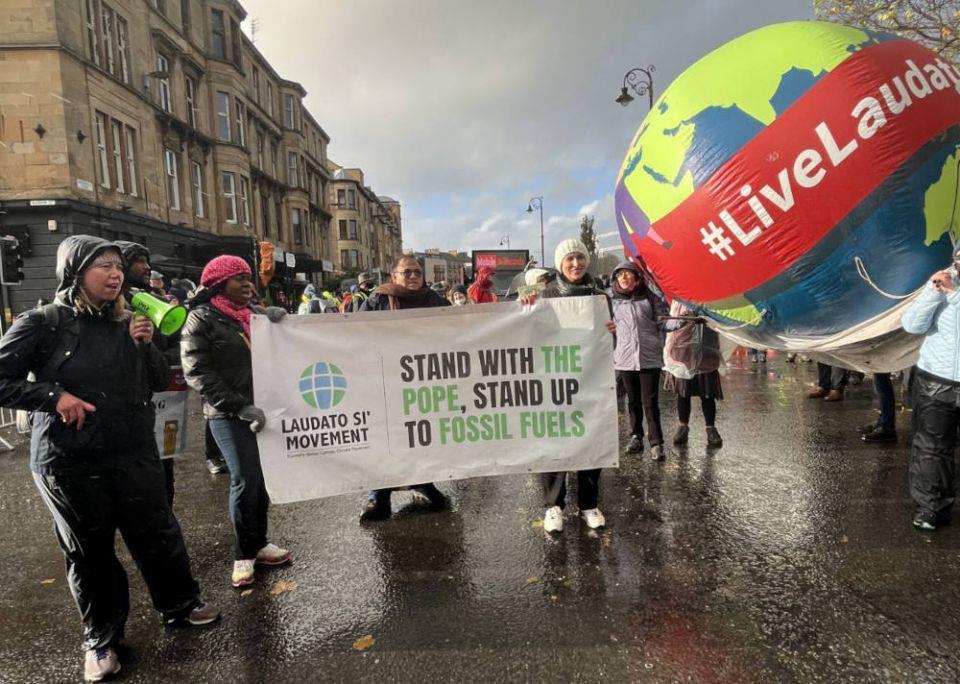
Dr. Lorna Gold (pictured left) Board chair, Laudato Si'
Movement (Alphonce Muia/CYNESA)
Movement (Alphonce Muia/CYNESA)
To learn more go to Earthbeat or Andrew's Blog #7
And so did some courageous Bishop Servant Leaders who set
an example at COP26 for all our Bishops.
And so did some courageous Bishop Servant Leaders who set
an example at COP26 for all our Bishops.
CATHOLIC BISHOPS MARCH IN CLIMATE MARCH Huge Glasgow Climate March for the Global Day of Climate Action. It is estimated that at least 120,000 people marched in Glasgow including some Catholic Bishops and priests with laity. ... all of us have a contribution to make, no matter how small our contribution, be it using less power, planting a tree, stop using plastics, whatever. All of us have and can contribute to restoring God’s creation to what it was.”
Another world is needed. Together it is possible!
Read more at Andrew's Blog #8.
Calling for a new way of thinking, feeling, understanding and living
The Laudato Si’ Action Platform empowers the universal Church
and all people of good will to respond to Laudato Si’, Pope
Francis’ encyclical on caring for our common home.
and all people of good will to respond to Laudato Si’, Pope
Francis’ encyclical on caring for our common home.
Download Here
View this newsletter in your browser and translate
Voir cette infolettre dans votre navigateur pour la traduire
George Pennier, a Coast Salish artist, shared a dream about healing with Bishop Gray Gordon of Victoria, BC in 1998. Bishop Gary was so moved by the dream, he commissioned the above carving which depicts Chiwatenhaw (Joseph), a Huron Chief, and Echon (St. Jean de Brébeuf), circled by an eagle spindle whorl drum, representing the Spirit and the Creator; the two leaders working together in hope for a good path forward for future generations... Read more at Andrew's November Blog.
Joseph Chiwatenhwa helped the Jesuits translate hymns and prayers from French into Huron. [Listen and watch the famous Jesous ahatonhia Huron Carol by Heather Dale in Huron, French, English and American sign language although St Jean de Brébeuf himself is credited with the lyrics]. Learn More
Download Complete PDF File Here
View this newsletter in your browser and translate
Voir cette infolettre dans votre navigateur pour la traduire
A Call to New Ways
Let's begin with giving thanks
Launch pushed back to mid-November
Calling for a new way of thinking, feeling, understanding and living
In a letter announcing the new campaign, Cardinal Peter Turkson, prefect of the dicastery, formally invited Catholic organizations to join the Laudato Si' initiative during what he called "this crucial decade" for "radical societal transformation" as increasing climate change and environmental degradation threaten both the planet's ecosystems and people.
The new target date, Nov. 14, is the World Day of the Poor, which Francis established in November 2016. The launch will also follow a major U.N. climate conference, COP26, to be held in Glasgow, Scotland, Nov. 1-12. That could be symbolic, Kureethadam told working group members, because once the conference is over, "we get to do action."
The new target date, Nov. 14, is the World Day of the Poor, which Francis established in November 2016. The launch will also follow a major U.N. climate conference, COP26, to be held in Glasgow, Scotland, Nov. 1-12. That could be symbolic, Kureethadam told working group members, because once the conference is over, "we get to do action."
Learn more at Andrew's October Blog
To help understand the goals see the
Cry of the Earth, Cry of the Poor Action Card
(from the Laudato Si' Action Platform website)
With a review of the website Resources page, you will already find a number of great resources to help parishes, groups, and individuals to develop teaching and sharing programs suited to most needs. And there are more to come!
Where to Begin?
“Calling for a new way of thinking, feeling, understanding and living.”
In this edition of the Common Good, we present the book, Climate Generation, Awakening to Our Children’s Future by Lorna Gold. It focuses on the climate crisis we are currently facing. George's blog takes several passages from the chapter titled Embracing the Earth. We pass on these thoughts at this time in the light of the Laudato Si’ Action Platform.
Calculate your ecological footprint
How many planets would we need if everyone lived like you?
Take the Foot Print Calculator
Laudato Si' Plus
We must care for God's creation; we must protect the Earth and all that lives on it. Otherwise, our children and grandchildren will experience the apocalypse.” (LS 217)
Fratelli Tutti elevates politics to a “lofty vocation and one of the highest forms of charity, inasmuch as it seeks the common good” (FT. 180).
Fratelli Tutti elevates politics to a “lofty vocation and one of the highest forms of charity, inasmuch as it seeks the common good” (FT. 180).
The Diocesan Phase of the Synodal Process 2021-2023 is an opportunity to listen more deeply to the voice of the Spirit, enhance participation and outreach, improve the quality of dialogue, discern about further issues, strengthen conversion in attitudes and skills, and animate people's sense of connection between the local, regional, and global church.
Overall, the Synod guidelines remind us that:
Overall, the Synod guidelines remind us that:
- The goal is to ensure the participation of the greatest number possible, in order to listen to the living voice of the entire People of God.
- This is not possible unless we make special efforts to actively reach out to people where they’re at, especially those who are often excluded or who are not involved in the life of the Church.
- There must be a clear focus on the participation of the poor, marginalized, vulnerable, and excluded, in order to listen to their voices and experiences.
- The Synodal Process must be simple, accessible, and welcoming for all.
Have you heard about a Diocesan Phase or a Synodal Team in your Diocese?
Learn more at Andrew's October Blog
|
Caritas Canada
D&P Fall Action Campaign |
See Complete Newsletter Here
September Season Of Creation - The Federal Elections
View this newsletter in your browser and translate
Voir cette infolettre dans votre navigateur pour la traduire
Voir cette infolettre dans votre navigateur pour la traduire
Franciscan Voice Canada is proud to present this 50th issue of the Common Good
Season of Creation & Laudato si’ Action Platform
A timely reminder of why we work for justice, peace and integrity of creation from
Michael Cusato, OFM - See Andrew's September Blog
Season of Creation & Laudato si’ Action Platform
A timely reminder of why we work for justice, peace and integrity of creation from
Michael Cusato, OFM - See Andrew's September Blog
|
The 2021 Season of Creation 1 Sept-4 Oct is a very good way to actively engage with the world
Learn more about the Season of Creation |
“We also encourage bishops and ecclesial bodies to make statements to raise awareness about the Season of Creation, helping the faithful to realize that ‘living our vocation to be protectors of God’s handiwork is essential to a life of virtue; it is not an optional or a secondary aspect of our Christian experience’”
(LS 217).
Monsignor Bruno-Marie Duffé, Secretary of the Vatican’s Dicastery for Promoting Integral Human Development wrote, “I invite you to join advocacy initiatives such as the Healthy Planet, Healthy People Petition urging for bold action to protect creation in addition to other initiatives calling for new paths forward together.” [You may have already signed this petition, because Franciscan Voice Canada promoted and linked to it under Action-Take Action earlier in July. It will be presented to world leaders at the COP 26 United Nations climate summit in Glasgow, Scotland, 1-12 Nov 2021— a meeting Pope Francis plans to attend.]
Sign the Petition Learn more at Andrew's September Blog
(LS 217).
Monsignor Bruno-Marie Duffé, Secretary of the Vatican’s Dicastery for Promoting Integral Human Development wrote, “I invite you to join advocacy initiatives such as the Healthy Planet, Healthy People Petition urging for bold action to protect creation in addition to other initiatives calling for new paths forward together.” [You may have already signed this petition, because Franciscan Voice Canada promoted and linked to it under Action-Take Action earlier in July. It will be presented to world leaders at the COP 26 United Nations climate summit in Glasgow, Scotland, 1-12 Nov 2021— a meeting Pope Francis plans to attend.]
Sign the Petition Learn more at Andrew's September Blog
Download Complete September Newsletter Here
Secular Franciscan JPIC Newsletter Issue 49, August 2021
- The movement is now called the Laudato Si’ Movement. A change that has the support of Pope Francis.
- As part of a two-year synodal process, the mission, values, and structures have also been changed and improved.
- The Laudato Si’ Movement celebrates and embraces all initiatives born from the encyclical and all organizations working for ecological and climate justice.
Laudato Si' Plus
"In faith and confidence, we walk forward in communion with our wider Catholic family, all people of goodwill, and every creature on our planet singing as we go, praising our beloved Creator, so that “our struggles and our concern for this planet never take away the joy of our hope” (LS 244).
View this newsletter in your browser and translate
Voir cette infolettre dans votre navigateur pour la traduire
Issue No 48, July 2021
View this newsletter in your browser and translate
Voir cette infolettre dans votre navigateur pour la traduire
Voir cette infolettre dans votre navigateur pour la traduire
National Crime: Indian Residential
Schools & Unmarked Graves
|
Columbia in Vancouver, BC, explained some of the difficulty in identifying the children and the cause of death. She said there is ample evidence of inadequate records. For example, some children were recorded with no first or last names, such as “Indian Girl No. 237.”
How ironic & deplorable that Davin [Nicholas Davin who is considered one of the architects of the Canadian Indian Residential School system.] has such a grave marker (left) in sharp contrast to most First Nations children who died in the schools & lie either in unmarked graves or like the one in the photo on the right... How could this have happened? One explanation: Government, police, church and news media collaborated; Story by Story, Canada’s News Media Built Indigenous Oppression How relentlessly racist framing helped ‘write’ the Indian Act — and persists today... Author Katłįà (Catherine) Lafferty wrote: “On July 6, 1885, Sir John A. Macdonald rose in Parliament to reaffirm the by then well-established colonial portrait of Indigenous peoples as a danger to society and spreaders of illness. “I have not hesitated to tell this House, again and again, that we could not always hope to maintain peace with the Indians; that the savage was still a savage, and that until he ceased to be savage, we were always in danger of a collision, in danger of war, in danger of an outbreak,” he said. Learn more at Andrew's July Blog |
Mary Ellen Turpel-Lafond, director of the Indian Residential School History and Dialogue Centre at the University of British
From Gospel To LifeThe sacrament of creation is summed up in the offertory prayer: 'Blessed are you Lord God of all creation. Through your goodness we have this bread to offer, which earth has given and human hands have made. It will become for us the bread of life.' 'Blessed are you Lord God of all creation. Through your goodness we have this wine to offer, fruit of the vine and work of human hands. It will become our spiritual drink.' To which we answer, 'Blessed be God for ever.'
|
Secular Franciscan JPIC Monthly - June 2021 Issue #47
the
Issue No 47, June 2021View this newsletter in your browser and translate
Voir cette infolettre dans votre navigateur pour la traduire Laudato Si' Action Platform
to "become totally sustainable, in the spirit of integral ecology"
Caring for our brothers and sisters means caring for the home we share. This responsibility is “essential to a life of virtue” (LS 217). Pope Francis introduces the Laudato Si' Platform The Dicastery for Promoting Integral Human Development’s Laudato Si’ Action Platform is a space for institutions, communities, and families to learn and grow together. You are warmly invited to join this community. Your unique “culture, experience, involvements, and talents” are needed on our journey towards greater love for our Creator, each other, and the home we share. (LS 14) ... Learn more
|
Pope's Prayer Intention
|
CATHII's Prayer For Earthday |
Prière Du CATHII Jour De La Terre |
Please spread the word and distribute the Earth Day Prayer widely.
Veuillez passer le mot et diffuser largement la prière du Jour de la Terre.
Veuillez passer le mot et diffuser largement la prière du Jour de la Terre.
April 22, 2021
|
Earth Day (English version)
Download Here |
Jour De La Terre (version française)
télécharger ici |
Franciscan Voice Canada, a network of Secular Franciscans and their friends who are a voice for change in the areas of justice, peace and integrity of creation, according to Franciscan values in our daily lives.
|
see the November issue of the Common Good See the most recent newsletter with links to past newsletters. |
The Franciscan Voice Canada (FVC) website was a Justice Peace and the Integrity of Creation initiative of the embryo National JPIC Commission (English Sector) of the National Fraternity of Canada of the Ordo Franciscanus Sæcularis (OFS - Secular Franciscan Order). FVC evolved from the National JPIC Action Plan 2012 which was affirmed by the National Chapter of Elections, 27 May 2012, following which suggestions for a website and JPIC newsletter were made by the National Minister and others.
The official JPIC structures in the OFS are presently undergoing change driven internationally by decisions of the 2017 General Chapter and in Canada of the 2018 National Chapter. Some Regional Fraternities are also considering changes. FVC is independent; its volunteer editors are not appointed by the National Council; but consider themselves responsive to that Council. The editors ensure content is in accord with Catholic Social Doctrine especially the encyclical Laudato Si’; the OFS Rule, General Constitutions & National Statutes of Canada; the Franciscan Family and Canadian Conference of Catholic Bishops JPIC initiatives, etc. FVC is particularly concerned about the future of our Sister Mother Earth in the face of climate change, the loss of biodiversity and unequal distribution of wealth. These are the most serious problems facing future generations and call for commitment to urgent and unprecedented responses. Learn more at Franciscan Voice Canada |

